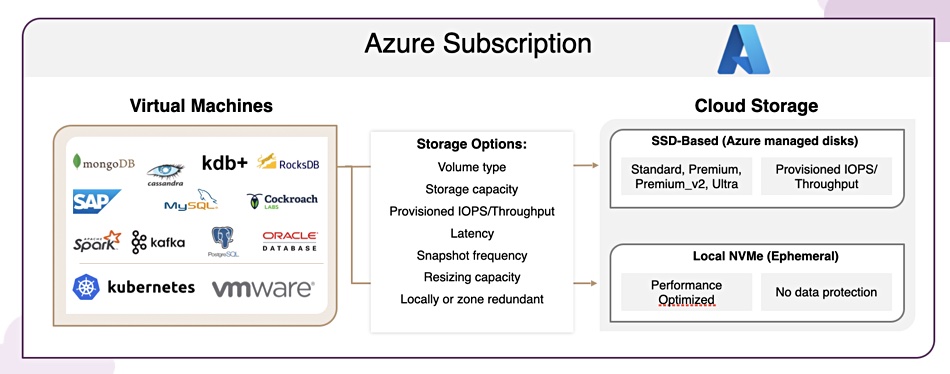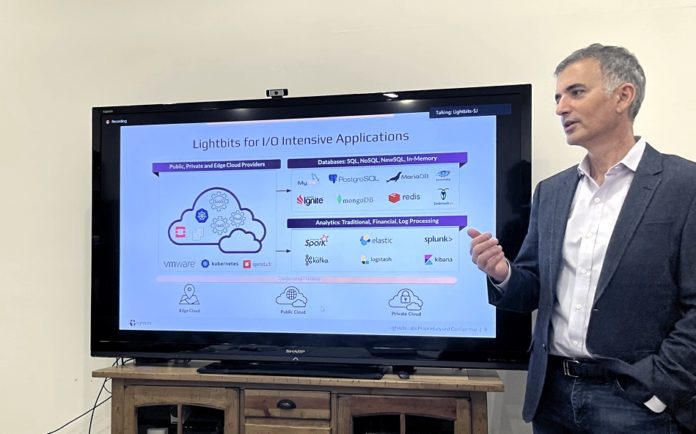Startup Lightbits is offering full SAN-in-the-Cloud data services built on top of raw, ephemeral and fast NVMe instances for both the AWS and Azure clouds.
Lightbits is the fourth storage company I have come across that is taking advantage of public cloud ephemeral storage instances to provide block storage that is both faster than and more affordable than the cloud provider’s own block storage instances – EBS in AWS’s case. The other three vendors are Silk, Dell with PowerFlex and Volumez. Interestingly all four orgs have Israeli backgrounds.

Lightbits’ strategy was presented in a briefing by co-founder and CSO Kam Eshghi and chief system architect Abel Gordon.
Back in 2019, Lightbits, which was founded in 2015, had developed its NVMe/TCP-using SuperSSD Ethernet-attached all-flash appliance and hardware acceleration card. Its LightOS software could also run on commodity hardware and supply block storage as fast as, for example, all-flash arrays from Pure Storage and NetApp but at considerably lower cost.
In late 2022 it started talking publicly about porting its Lightbits software to the public cloud, as the Lightbits Cloud Data Platform, and demoed this at AWS re:Invent. The software provided block storage by using, it said, Intel-based storage-optimized Elastic Compute Cloud (EC2) instances. Normally SAN storage software ported to Amazon’s public cloud will use Elastic Block Store (EBS) instances and will provide a suite of data services on top of EC2, including compression, thin provisioning, snapshots, etc. The EC2 storage is raw and not persistent, going away when the instance is shut down.

Lightbits on AWS is now available, both as a bring-your-own-license (BYOL) offering and in AWS’s marketplace. It provides auto-scaling, thin provisioning, unlimited backup and restores, snapshots and clones and it can provide block storage to any EC2 instance type. This is block storage with a high IOPS rating and consistently low latency.
It is also, Eshgi said, much easier to set up and use than EBS storage, which has to be provisioned one volume at a time. Lightbits will support multi-availability zones for its AWS storage and AWS does not have that.
Azure

Lightbits is also available on Azure, in BYOL form but with a managed application marketplace offering coming later in the year. Gordon reckoned setting up Azure native block storage “is great for many use-cases but complex and costly for storage-intensive applications.” Lightbits setup is relatively easy and Gordon showed a performance slide of Lightbits’ Azure scalability and latency:

The left-hand chart is for reads and the green, blue and dark gray lines show the IOPS numbers for three, six, and nine servers respectively – which rise as the queue depth increases from 8 to 128. The nine-server IOPS line reaches almost three million IOPS.
The three bars (blue, orange and gray) show the 99th percentile tail latency for nine, six, and three servers respectively. They are all quite consistent, with only the rightmost 128-deep queue entry showing much variation.
The right-hand chart is for writes and shows higher latencies and lower IOPS – as would be expected.
Lightbits performance in Azure when supplying an Oracle database scales up to almost a million IOPS whereas Azure’s own Ultra Disk tops out at 80,000 IOPS.

An Oracle performance evaluation with Lightbits storage shows it reaching almost to one million IOPS when only reading, and progressively going down to over 250,000 IOPS when only writing. It is very much faster than Azure’s own Ultra Disk instances with their 80,000 IOPS when only reading.
These charts make Lightbts in the public cloud an attractive proposition. With Oracle for example, fewer Oracle licenses could be needed at a particular performance level. Lightbits also charges by cluster whereas an alternative Azure EBS 102 facility charges by provisioned IOPS and capacity. Oracle is limited to specific instance types and multiple Oracle instances can be needed to reach a target TPS number. Lightbits claims a single one of its volumes on Azure can support high Oracle TPS.
Customers with Lightbits systems on-premises can transfer their licenses to the public cloud Lightbits instances if they wish.
Workloads of interest to Lightbits in the cloud are databases and AI – specifically data pre-processing, model training, real-time inference, and database optimization.
Looking at the Lightbits competition we understand that Volumez’s offering is fundamentally a control plane, and doesn’t provide a full Lightbits-style storage stack. Silk is similarly a high-performance offering but with limited data services.
We should position Lightbits in AWS and Azure as providing a full storage stack with data services, high IOPS and low latency, whereas legacy SAN vendors porting their software to the cloud on EBS-style instances also provide data services – but not with the performance (IOPS and latency) of Lightbits.
Get a solution brief document discussing Lightbits in AWS here and a Lightbits on Azure solution brief here.
Bootnote.
The LightOS software name was retired in 2021 in favour of calling it just Lightbits software.








